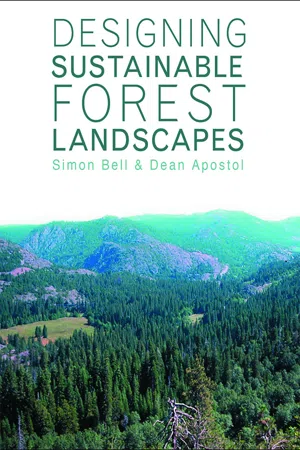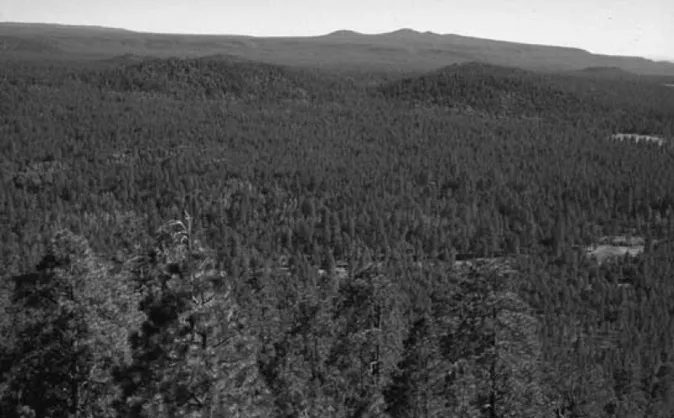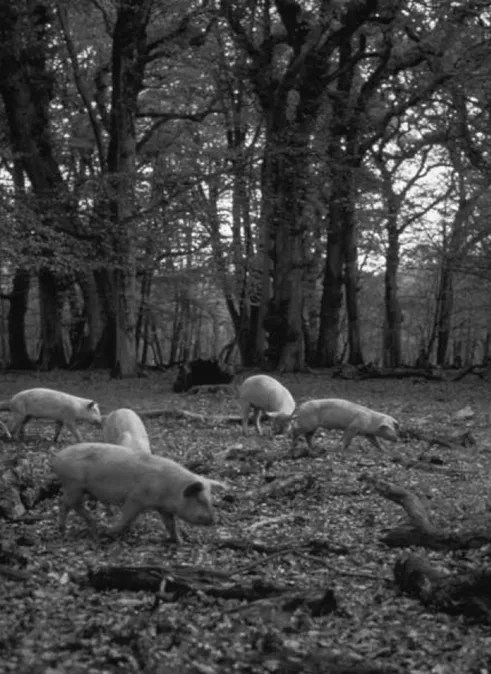Chapter 1 Planning and forest design
Introduction
“Planning”, according to Dr Robert Ribe of the University of Oregon, “is a natural social activity that grows out of the need for cultures to have some measure of control over their future.” Thus, what is often thought of as an invention of the enlightenment of politicians and technocrats is in reality something that has been around for a much longer time.
Planning has come to be an essential tool in modern forest management. This is in large part due to the long time frame over which a forest grows and matures, as well as the desire by owners and managers to be able to predict how much and when they can harvest timber and manage investments. It is also due both to the increasingly public nature of forest management, particularly in western democracies, and the traditions of central planning of all aspects of the economy in the former Soviet Union and other Eastern European countries. Planning provides a structured process by which multiple conflicts can be addressed, while also (hopefully) providing a clear vision of how the forest will be managed over many years.
This chapter reviews a range of historical approaches to forest planning. It then demonstrates how forest landscape design can be used as a tool to incorporate and synthesise the best from them while also going further to address modern challenges. Alternative approaches to forest planning developed due to historical circumstances, although none has completely ceased to be used or to have an influence into the present day.
Traditional forest planning
Traditional cultures were (and remain) much more sophisticated in their interaction with the environment than we in modern, advanced cultures have appreciated until recently. In the Americas, for example, native people were not simply hunter-gatherers, but in many areas also practised agro-forestry for thousands of years. Methods varied, but included swidden (slash and burn) agriculture, maintenance of clearings and glades through repeated prescribed burning, and conscientious game management. The character of North American forests, often open and dominated over wide areas by pine and oak species at the time of European contact, was largely a consequence of deliberate under-burning that facilitated and integrated food gathering, travel and hunting. Burning shaped and maintained woodland conditions that maximised their utility to human cultures. Can we consider that burning was deliberately planned in the sense that we understand the term?
Figure 1.1 Ponderosa pine forests in the American West, such as this example in Sitgreaves National Forest in Arizona, USA, were managed by native peoples using controlled fire. This is an example of non-scientific forest management, which satisfied the needs of the time.
Native Americans did not make maps of forests, nor did they divide them into rectilinear compartments. But they apparently had a keen sense of what to burn and when, activities that required forward thinking. Huckleberry fields in the Pacific Northwest may have been burned on a 50-year cycle, indicating a multi-generational sense of planning and execution. Ponderosa pine forests throughout the West were burned on a 7–20-year cycle. Oak savannas may have been burned every 3–5 years to help stimulate acorn production. Native peoples knew that fire travelled better up slopes, and used the receding snow line in the California Sierras as a seasonal firebreak.
Planning for fire use was probably largely intuitive, but was also based on generations of trial and error, with serious consequences if the wrong choice was made. Either too much or too little fire would damage fragile resources upon which the community depended. In the absence of a written language, oral traditions were followed to hand down forest management techniques from generation to generation. Typically this was from grandparent to grandchild, perhaps to ensure it was transmitted as far ahead as possible. By nature this approach was conservative. Since the economy was largely subsistence and transport of large objects out of the forest was not feasible, resource exploitation rarely exceeded the sustainability of the land. However, oral plans can be just as effective as the written plans we depend upon today, in the same way that oral contracts can have similar legal standing to written ones. Essential planning elements, including clear objectives, timing, location and application technique were all used. The maintenance of pine and oak for food and fuel, of grasses and herbaceous plants for food and medicine, and open ground for hunting and travel were essential resources of the day that depended upon planning and execution.
However, in addition to burning to clear areas for resource production, hunting and gathering, timber was and remains an important resource for native cultures. In the Pacific Northwest of the USA, native people were skilled woodworkers, and in particular harvested part or all of western red cedar trees, known as the “tree of life”. From the cedar bark they made clothing, baskets and diapers. They split planks from standing trees for building lodges. They harvested whole trees to shape timbers and large, seaworthy canoes. They also harvested many other trees, including Sitka spruce, Pacific yew, grand fir, cottonwood and willows. Red alder was prized for woodworking and to smoke salmon for winter storage or trade.
Medieval European people followed a similar oral tradition approach to forest planning and management. Large tracts of European forests were gradually cleared to make way for farming over a 5, 000-year period. Swidden agriculture was commonly practised in many places, where patches of forest were cleared by burning and farmed for a few years, until the soil fertility was exhausted. The patch was then allowed to regenerate over a variable period of time (depending on fertility and climate), while another was cleared and farmed. In some areas permanent clearings were made, and soil fertility carefully managed to prevent its exhaustion.
Gradually, a pattern of land use developed that included a village or hamlet located near fresh water, surrounded by fenced gardens, grainfields on the best soils and perhaps some pasture or hay meadow. A “forest common” lay just beyond the fields, and was used as a source of wood and grazed by livestock, and could serve as an escape area during periods of unrest. Beyond the commons was often a wild forest area reserved for hunting by the local royalty or aristocracy. In the later middle ages, the first foresters were law enforcement officers who kept the peasants out of the parts of the woods reserved for hunting to make sure that prized game was not illegally taken.
The working boundaries of medieval European forests were probably more precise than was the case with forests “managed” by Native Americans. Dating all the way back to Roman times, there was consistent use of a three-part zoning or division of the forest. The first zone was called the silva caedua, where coppicing for firewood and small round wood used for many purposes was practised. Cutting might be on anywhere from an annual to an eight- or twelve-year cycle depending on the productivity of the forest and the types of species present. The coppice woodland was divided into sections (cants) of roughly equal area, at least as many as there were years in the cutting cycle, ensuring a constant supply of small wood.
The second zone was called the silva glandifera or silva saginacia. This area was managed as wooded pasture, with domestic animals allowed to graze under tall trees. Acorns were particularly important forage, with pigs being the most important animals in many areas.
The third zone was a protected area where regular harvest of materials was prohibited. It was set aside and managed by higher authorities and landlords, and had its own special set of forest laws. Its primary purpose was a hunting ground for the royalty and aristocracy, but it also served as a buffer zone between settled areas and estates. It was also a conservation zone dedicated to the protection of favoured wildlife, most particularly deer. Sometimes it was referred to as forestis silva, and was thought of as separate from the tamed, managed landscape.
This three-part pattern of forest division continued throughout the middle ages. Coppice woods provided firewood, tools, stakes, basket-making materials and many other uses. Grazed forests provided tall trees for use in construction of important buildings. While the large trees could be taken for specific uses (e.g. construction of cathedrals), they could not be traded or sold. Other uses of the forest were allowed, including bee taking, and gathering of leaves, bark or other products for forage or soil amendments.
Medieval forest managers planned far ahead, and some mature trees were always kept to provide seed for the next generation. In some cases individual trees were retained for many generations, became “old growth” or “veteran trees” and were revered by the local community. Harvested trees were “rummaged”, or selected here and there over a broad area. Some areas were managed to grow very large timber, on up to 300-year cycles for oak. Coppice-with-standards woodlands were true multiple-use forests that included firewood gathering, hunting, grazing and timber cutting.
According to Bechmann, the medieval forest management system was stable and sustainable for 1,000 years or more in many locations. One reason was that the population during the first few centuries after the fall of the Roman Empire remained low due to political instability, wars, plagues, famines and social unrest. In some areas lands once cultivated reverted back to forest and were then cleared again as the population gradually re-established itself. Since trade between communities was restricted due to lack of safety in travel, local communities were very self-reliant.
Relatively peaceful times in the eleventh-thirteenth centuries led to a significant increase in the population, which in turn led to pressure to clear more forest to make way for expanding agricultural crops. Forests began to become over-exploited, gradually leading to changes in the way they were administered. Decrees against forest clearing for agriculture were issued as early as the twelfth century in the Rhine region, and in the thirteenth century in France.
Figure 1.2 Pigs are still allowed to forage for beech mast and acorns in the New Forest in England, following the ancient practice of pannage. This is part of the historic development of rights held by commoners in the royal hunting forest, which still retains its own laws and officers.
Silvicultural forest planning
Bechman notes that the first recorded instance where a forest was divided into definite compartments to help management was in 1359, in the City Forest of Erfurt. This idea soon caught on, and in fourteenth-century France under Charles V, “coupes d’assiettes” were designated. These were areas where forest agents managed selection cutting, a practice that replaced rummaging. This period marks the time when forest management by specialists began to displace the local community in decision making about what and where to harvest trees. “Coupe” is the word used to describe an area to be felled, from a French forestry term, derived from couper, the verb to cut. Coupes were specified to be 5–6 ha in size. The trees were to be cut flush to the ground, assuring there would be no waste, and they had to be cut level (in typical French fashion, a litre of wine had be able to rest on the cut stump!). A new term, “coupe de reglée”, was used to distinguish cutting within specified sectors as opposed to traditional random selection.
Figure 1.3 An ancient coppice forest.
Gradually forests and farms, once viewed as intertwined and integrated, came to be seen as very separate land uses. Many forests became reserved for the exclusive use of the lords and their agents, who developed into the profession of forester. Forests came to be seen as economic assets, with timber the primary economic product. This led to the development of “scientific forestry”, where careful record keeping combined with experimental methods to improve yields were tested and improved. Clearcutting, which we often think of as a twentieth-century innovation that reflects industrial forestry, was actually introduced into forests in Germany in 1454.
The systematic recording of forest compartments led to the laying out of rectangular coupes to help calibrate harvest and predict growth with some mathematical precision. German foresters perfected this system, which became known as “Schlagwaldwirtschaft”. Essentially, this is growing and cutting of trees section by section or area. The goal was to ensure the sustainability of trees over the long term at a rate of perpetual maximum utilisation. This was the first true scientifically based forestry, with field experiments to determine the physiological characteristics of tree species and optimal conditions for growth. The information from these experiments was transferred to the field, and silvicultural planning was born.
Figure 1.4 An old photograph from Russia in around 1905 shows extensive strip fellings in the forest. This is a particular form of silvicultural system still practised in many places. It could be argued that this repeated pattern is not very visually attractive. Source: Library of Congress.
As the father of modern German silviculture, Heinrich Cotta pointed out in 1816 that silviculture developed in response to a scarcity of wood:
The emergence of scientific forest management displaced not only agro-forestry, but also the hunting use of the forest, where forests that had been reserved as deer habitat were liberated from this exclusive use. Artificially high populations of deer in reserved forests had resulted in a lack of regeneration, which was unacceptable when wood became the resource of greater economic importance to the landlords
There are three aspects of the Schlagwaldwirtshaft system that have influenced forest planning right up until the pr...




